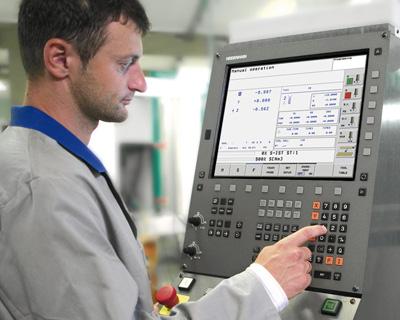
HEIDENHAIN has released the newest software for the compact but versatile contouring control, the TNC 320. The TNC 320 sports three axes plus spindle with the possibility of adding an additional axis, and is the perfect control for universal milling, drilling and boring machines.
The new end-user functions/cycles available through the new TNC 320 software include engraving, either in a straight line or on an arc. Also new manual probing cycles have been added as well as support for the latest HEIDENHAIN handwheels
For the machine builder, it is now possible to encrypt part of the control's PLC partition to secure the machine manufacturers proprietary information. This and the ability to lock external access, new touch probe configuration parameters and operation of the integrated oscilloscope from the NC program makes this an especially efficient control.
This, along with the TNC 320's overall shop-oriented programming, simple operation and offline program creation make this control the most efficient in its class.
As always, the TNC 320 can be integrated into networks and connected with PCs, programming stations and other data storage devices. It features the latest generation Fast Ethernet interface, andcommunicates with NFS servers and Windows networks in TCP/IP protocol without needing additional software.
Contact Details
Related Glossary Terms
- boring
boring
Enlarging a hole that already has been drilled or cored. Generally, it is an operation of truing the previously drilled hole with a single-point, lathe-type tool. Boring is essentially internal turning, in that usually a single-point cutting tool forms the internal shape. Some tools are available with two cutting edges to balance cutting forces.
- gang cutting ( milling)
gang cutting ( milling)
Machining with several cutters mounted on a single arbor, generally for simultaneous cutting.
- milling
milling
Machining operation in which metal or other material is removed by applying power to a rotating cutter. In vertical milling, the cutting tool is mounted vertically on the spindle. In horizontal milling, the cutting tool is mounted horizontally, either directly on the spindle or on an arbor. Horizontal milling is further broken down into conventional milling, where the cutter rotates opposite the direction of feed, or “up” into the workpiece; and climb milling, where the cutter rotates in the direction of feed, or “down” into the workpiece. Milling operations include plane or surface milling, endmilling, facemilling, angle milling, form milling and profiling.
- numerical control ( NC)
numerical control ( NC)
Any controlled equipment that allows an operator to program its movement by entering a series of coded numbers and symbols. See CNC, computer numerical control; DNC, direct numerical control.







